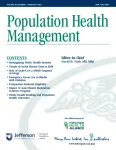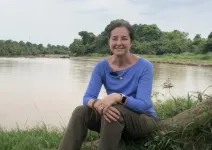(Press-News.org) Researchers have developed a way to create photonic time crystals and shown that these bizarre, artificial materials amplify the light that shines on them. These findings, described in a paper in Science Advances, could lead to more efficient and robust wireless communications and significantly improved lasers.
Time crystals were first conceived by Nobel laureate Frank Wilczek in 2012. Mundane, familiar crystals have a structural pattern that repeats in space, but in a time crystal, the pattern repeats in time instead. While some physicists were initially sceptical that time crystals could exist, recent experiments have succeeding in creating them. Last year, researchers at Aalto University’s Low Temperature Laboratory created paired time crystals that could be useful for quantum devices.
Now, another team has made photonic time crystals, which are time-based versions of optical materials. The researchers created photonic time crystals that operate at microwave frequencies, and they showed that the crystals can amplify electromagnetic waves. This ability has potential applications in various technologies, including wireless communication, integrated circuits, and lasers.
So far, research on photonic time crystals has focused on bulk materials – that is, three-dimensional structures. This has proven enormously challenging, and the experiments haven’t gotten past model systems with no practical applications. So the team, which included researchers from Aalto University, the Karlsruhe Institute of Technology (KIT), and Stanford University, tried a new approach: building a two-dimensional photonic time crystal, known as a metasurface.
‘We found that reducing the dimensionality from a 3D to a 2D structure made the implementation significantly easier, which made it possible to realise photonic time crystals in reality,’ says Xuchen Wang, the study’s lead author, who was a doctoral student at Aalto and is currently at KIT.
The new approach enabled the team to fabricate a photonic time crystal and experimentally verify the theoretical predictions about its behaviour. ‘We demonstrated for the first time that photonic time crystals can amplify incident light with high gain,’ says Wang.
‘In a photonic time crystal, the photons are arranged in a pattern that repeats over time. This means that the photons in the crystal are synchronized and coherent, which can lead to constructive interference and amplification of the light,’ explains Wang. The periodic arrangement of the photons means they can also interact in ways that boost the amplification.
Two-dimensional photonic time crystals have a range of potential applications. By amplifying electromagnetic waves, they could make wireless transmitters and receivers more powerful or more efficient. Wang points out that coating surfaces with 2D photonic time crystals could also help with signal decay, which is a significant problem in wireless transmission. Photonic time crystals could also simplify laser designs by removing the need for bulk mirrors that are typically used in laser cavities.
Another application emerges from the finding that 2D photonic time crystals don’t just amplify electromagnetic waves that hit them in free space but also waves travelling along the surface. Surface waves are used for communication between electronic components in integrated circuits. ‘When a surface wave propagates, it suffers from material losses, and the signal strength is reduced. With 2D photonic time crystals integrated into the system, the surface wave can be amplified, and communication efficiency enhanced,’ says Wang.
END
A new type of photonic time crystal gives light a boost
Smart surfaces mimic elusive photonic time crystals
2023-04-05
ELSE PRESS RELEASES FROM THIS DATE:
Beneath the Earth, ancient ocean floor likely surrounds the core
2023-04-05
Embargoed: Not for Release Until 2:00 pm U.S. Eastern Time Wednesday, 05 April 2023.
TUSCALOOSA, Ala. — Through global-scale seismic imaging of Earth’s interior, research led by The University of Alabama revealed a layer between the core and the mantle that is likely a dense, yet thin, sunk ocean floor, according to results published today in Science Advances.
Seen only in isolated patches previously, the latest data suggests this layer of ancient ocean floor may cover the core-mantle boundary. Subducted underground long ago as the Earth’s plates shifted, this ultra-low velocity zone, or ULVZ, is denser than the rest ...
Most existing methods to tackle conspiracy beliefs are ineffective, study finds
2023-04-05
A new review of methods for reducing conspiracy beliefs has shown that most methods are ineffective, but that those focused on fostering critical thinking or an analytical mindset show some promise.
Led by researchers at University College Cork (UCC), the study is the first comprehensive review of the effectiveness of various conspiracy interventions. It is published in PLOS ONE.
While holding conspiracy beliefs has been associated with several detrimental social, personal, and health consequences, little research has been dedicated to systematically reviewing the methods that could reduce conspiracy beliefs.
To ...
Creating a blueprint for optimized ear tubes and other implantable fluid-transporting devices
2023-04-05
By Benjamin Boettner
(BOSTON) — Infections of the middle ear, the air-filled space behind the eardrum that contains the tiny vibrating bones of hearing, annually affect more than 700 million people worldwide. Children are especially prone to ear infections, with 40% of them developing recurrent or chronic infections that can lead to complications like impaired hearing, speech and language delays, perforations in their eardrums, and even life-threatening meningitis.
As a treatment, doctors may surgically insert ear tubes knowns as “tympanostomy tubes” (TTs) into the eardrum to create an opening between the ear canal ...
Humans vs. Bacteria: Differences in ribosome decoding revealed
2023-04-05
Memphis, Tenn.—April 5, 2023) Scientists at St. Jude Children’s Research Hospital revealed that human ribosomes decode messenger RNA (mRNA) 10 times slower than bacterial ribosomes, but do so more accurately. The study, published today in Nature, used a combination of field-leading structural biology approaches to better understand how ribosomes work. The scientists pinpointed where the process slows down in humans, which will be useful information for developing new therapeutics for cancer and infections.
Ribosomes are ...
Solid-state lithium-sulfur batteries: Neutrons unveil sluggish charge transport
2023-04-05
The scientists designed a special cell in order to observe the transport of lithium-ions between the anode and the cathode in a solid-state Lithium-Sulfur battery. Since lithium can hardly be detected with x-ray methods, HZB physicists Dr. Robert Bradbury and Dr. Ingo Manke examined the sample cell with neutrons, which are extremely sensitive to lithium. In conjunction with Dr. Nikolay Kardjilov, HZB, they used neutron radiography and neutron tomography methods on the CONRAD2 instrument at the Berlin neutron source BER II1. Groups from Giessen (JLU), Braunschweig (TUBS) and Jülich (FZJ) were also involved in the work.
Lithium ...
Stripped to the bone
2023-04-05
Natural disasters can devastate a region, abruptly killing the species that form an ecosystem’s structure. But how this transpires can influence recovery. While fires scorch the landscape to the ground, a heatwave leaves an army of wooden staves in its wake. Storm surges and coral bleaching do something similar underwater.
UC Santa Barbara scientists investigated how these two kinds of disturbances might affect coral reefs. They found that coral struggles more to recover from bleaching than from storms, ...
Emory researchers discover key pathway for COVID organ damage in adults
2023-04-05
Even after three years since the emergence of COVID-19, much remains unknown about how it causes severe disease, including the widespread organ damage beyond just the lungs. Increasingly, scientists are learning that organ dysfunction results from damage to the blood vessels, but why the virus causes this damage is unclear. Now a multidisciplinary team of Emory researchers has discovered what they believe is the key molecular pathway.
Results of their study, published today in Nature Communications, show that COVID-19 damages the cells lining the smallest blood vessels, choking off blood flow. These results could pave the way for new treatments to save lives at a time when hundreds ...
Population Health Management
2023-04-05
The COVID-19 pandemic has underscored the inequality in American health care systems, which consistently neglect the needs of underserved communities, leaving them without access to quality care. A commentary published in Population Health Management highlights the need for a transformational change in our health care systems to advance health equity and address structural racism and health disparities affecting wellbeing. Click here to read the article now.
Coauthors Dr. Jonathan B. Perlin, President ...
Teens who trust online information find it less stressful
2023-04-05
ITHACA, N.Y. -- Teens’ trust in the news they consume on social media – or lack of it – may be key to whether it supports or detracts from their well-being, according to Cornell-led psychology research.
Surveying nearly 170 adolescents and young adults from the U.S. and U.K. early in the pandemic, the researchers found that those more trusting of the COVID-19 information they saw on Facebook, Twitter and TikTok were more likely to feel it was empowering, while those less trusting were more likely to find it stressful.
The findings highlight the need for news literacy programs to help young people discern fact-based, trustworthy sources from misinformation ...
WCS names new President and CEO - Monica P. Medina
2023-04-05
The Wildlife Conservation Society (WCS) announced today that Monica P. Medina, the first diplomat in the U.S. designated to advocate for global biodiversity, has been named WCS President and CEO, effective June 1, 2023. Medina, current Assistant Secretary of State for Oceans, Environment, and Science; and Special Envoy for Biodiversity and Water Resources will serve until April 30, 2023, at the U.S. Department of State.
Medina ushered in a new era of environmental diplomacy as a foreign policy priority at the State Department. She will join WCS to lead its mission to save wildlife and wild places, harnessing the power of its four zoos, an aquarium, and its Global ...
LAST 30 PRESS RELEASES:
University of Oklahoma researcher awarded funding to pursue AI-powered material design
Exploring how the visual system recovers following injury
Support for parents with infants at pediatric check-ups leads to better reading and math skills in elementary school
Kids’ behavioral health is a growing share of family health costs
Day & night: Cancer disrupts the brain’s natural rhythm
COVID-19 vaccination significantly reduces risk to pregnant women and baby
The role of vaccination in maternal and perinatal outcomes associated with COVID-19 in pregnancy
Mayo Clinic smartwatch system helps parents shorten and defuse children's severe tantrums early
Behavioral health spending spikes to 40% of all children’s health expenditures, nearly doubling in a decade
Digital cognitive behavioral treatment for generalized anxiety disorder
Expenditures for pediatric behavioral health care over time and estimated family financial burden
Air conditioning in nursing homes and mortality during extreme heat
The Alps to lose a record number of glaciers in the next decade
What makes a good proton conductor?
New science reporting guide published for journalists in Bulgaria
New international study reveals major survival gaps among children with cancer
New science reporting guide published for journalists in Turkey
Scientists develop a smarter mRNA therapy that knows which cells to target
Neuroanatomy-informed brain–machine hybrid intelligence for robust acoustic target detection
Eight SwRI hydrogen projects funded by ENERGYWERX
The Lundquist Institute and its start-up company Vitalex Biosciences Announces Strategic Advancement of Second-Generation fungal Vaccine VXV-01 through Phase 1 Trials under $40 Million Competitive Con
Fine particles in pollution are associated with early signs of autoimmune disease
Review article | Towards a Global Ground-Based Earth Observatory (GGBEO): Leveraging existing systems and networks
Penn and UMich create world’s smallest programmable, autonomous robots
Cleveland researchers launch first major study to address ‘hidden performance killer’ in athletes
To connect across politics, try saying what you oppose
Modulating key interaction prevents virus from entering cells
Project explores barriers to NHS career progression facing international medical graduates
Jeonbuk National University researchers explore the impact of different seasonings on the flavor perception of Doenjang soup
Two Keck Medicine of USC Hospitals named Leapfrog Top Teaching Hospitals
[Press-News.org] A new type of photonic time crystal gives light a boostSmart surfaces mimic elusive photonic time crystals







